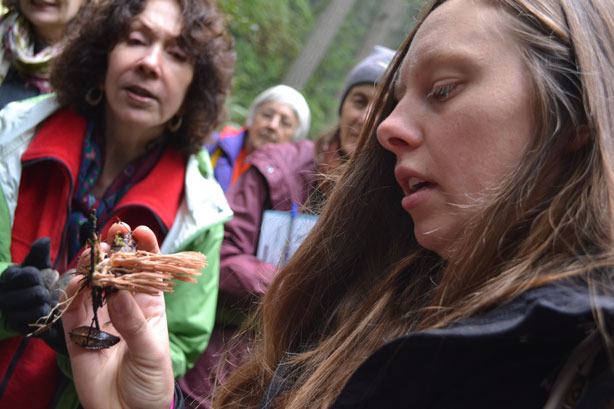On a misty morning Sunday, people gathered on South Whidbey to learn more about the fungi around them.
“They have a certain mystique about them because of their deliciousness and their dangerousness,” Maureen Freehill said.
Freehill was a mushroom enthusiast for a while. She took a class in the 1980s at The Evergreen State College and was hooked. When she heard about the “Walk and Talk with Fungi Tour” at the Whidbey Institute in Clinton she signed up immediately.
Approximately 20 people attended the morning event Saturday, Oct. 12, which was presented by the Whidbey Camano Land Trust.
The land trust planned to host one walking tour, but because the first class filled up within four hours, the nonprofit added a second tour, said Janelle Castro, the organization’s outreach and communications manager.
“It’s the right climate of warm and wet for mushrooms right now,” said Castro. “I was blown away by how many different types of fungus were out last Friday.”
The land trust partnered with the Whidbey Institute to use its trails for the tour.
Leading the tour was Ida Gianopulos, a Whidbey Camano Land Trust conservation assistant. Mushroom foraging is a popular tradition in Gianopulos’ family. She’s been searching for them since she could first walk — her mom is Swedish and it’s a very popular activity in that culture.
“I’m not an expert,” Gianopulos said. “I’m an enthusiast. I enjoy sharing that with others.”
Gianopulos is an ecologist, so she looks at how different elements of the environment fit and fight together.
“Fungi are a dominant force in our Northwest conifer forest. Without them these forests would not exist,” Gianopulos said.
Right away Gianopulos found an example on the trail: brown rot fungi. This fungus grows on dead trees and consumes the cellulose inside, which is the complex structural sugar that makes up the cell walls of plants. The only thing left when the fungus is finished is the lignin — the molecule that makes up wood and that no living organism can consume. The rot fungi have special enzymes that can dissolve it to make way for their cellulose consumption.
“It never breaks down,” Gianopulos said. “It crumbles and creates the forest floor.”
That’s why these woods have soft floors and absorb so much moisture, Gianopulos said.
Another type of fungi that is all around the forest is mycorrhizal fungi. It lives symbiotically with trees, Gianopulos said. The mycelium, which is the living body of the fungus, forms sheaths on a tree’s roots to take the simple sugars it needs to survive. In return, it stretches into the forest, bringing nutrients and water the tree wouldn’t receive on its own. Certain types of mycorrhizal fungi are associated with certain types of trees. For example, Oregon truffles are found growing under Douglas firs, Gianopulos said.
Another way to identify mushrooms is by their smell. Some smell like fish, cleaning products, or dried fruits, Gianopulos said. Chanterelles sometimes smell like dried apricots. One of the russulas that was passed around was described as “smelling like a scallop.”
Mushrooms are the fruit of the fungus, Gianopulos said. They like being picked because they release spores into the environment. It is the same as an apple tree growing fruit for animals to disperse and increase the plant population.
And much like a tree, the fungus is much bigger than the fruit it actually produces. Gianopulos said. It’s hard to tell how far the mycelium stretches in the forest.
Mushrooms also contain chitin, which is also found in arthropods and crustaceans. Gianopulos said this is what makes fungi different from plants.
There were also examples of fungi fighting along the trail. One of the logs contained three different types at war with one another, and Gianopulos said that if the log were to be cut open, you would see a black line where the battle was raging. Each fungus releases chemicals which create a zone line that repels the other.
“They are not happily coexisting,” Gianopulos said. “They are tolerating each other and staying on their side of the log.”
Gianopulos offered a few tips for mushroom foragers. For those who seek out edible mushrooms, it is important to make sure they are cooked. Some mushrooms, such as morels, are poisonous until cooked. And make sure to try a small amount first before feasting to avoid getting sick, even if they are chanterelles or oyster mushrooms.
One aspect Freehill likes about fungi is that they can appear and disappear overnight.
So for those planning to go in search of mushrooms, its better to head out sooner than later.



